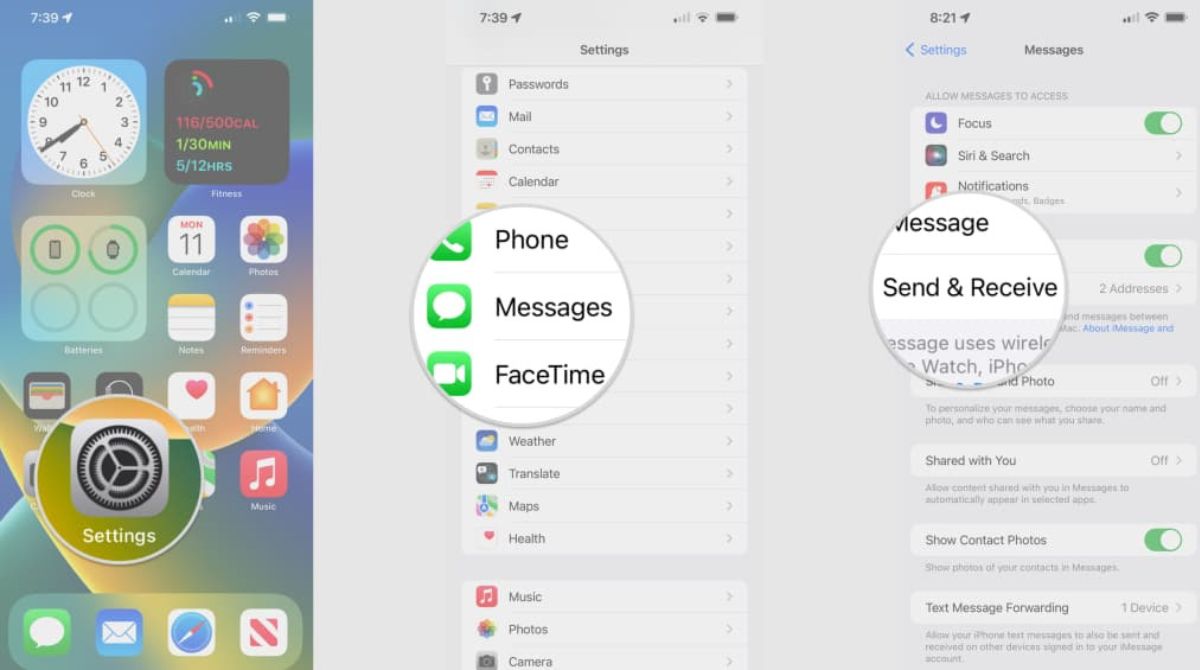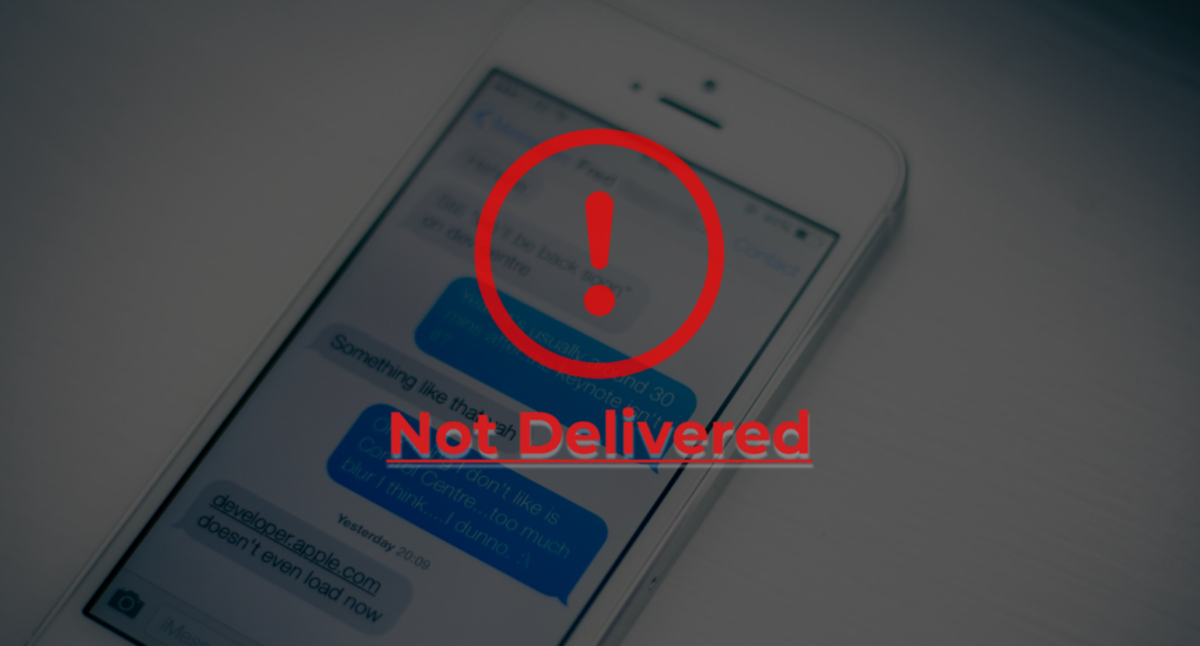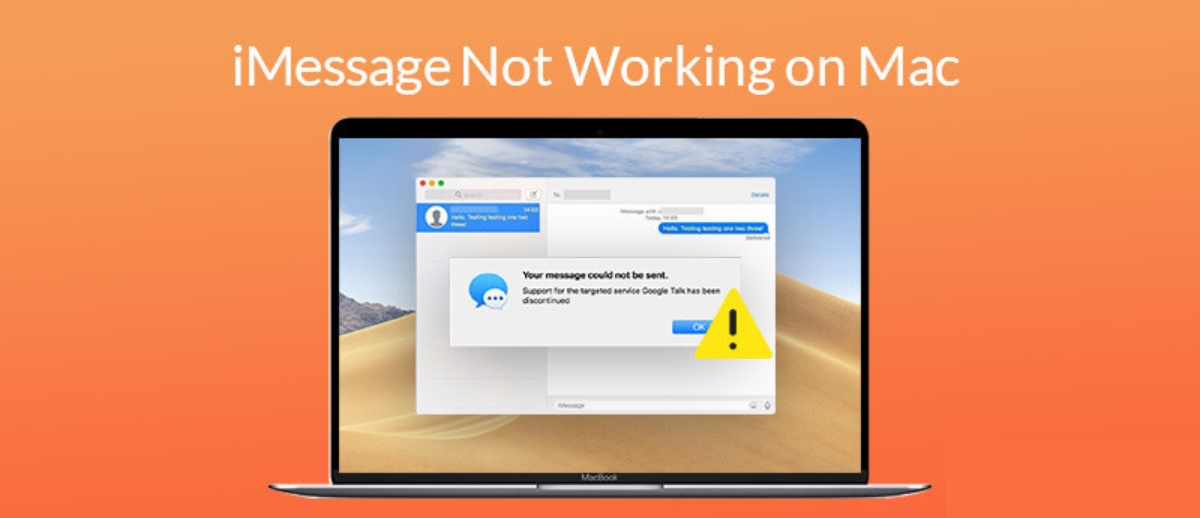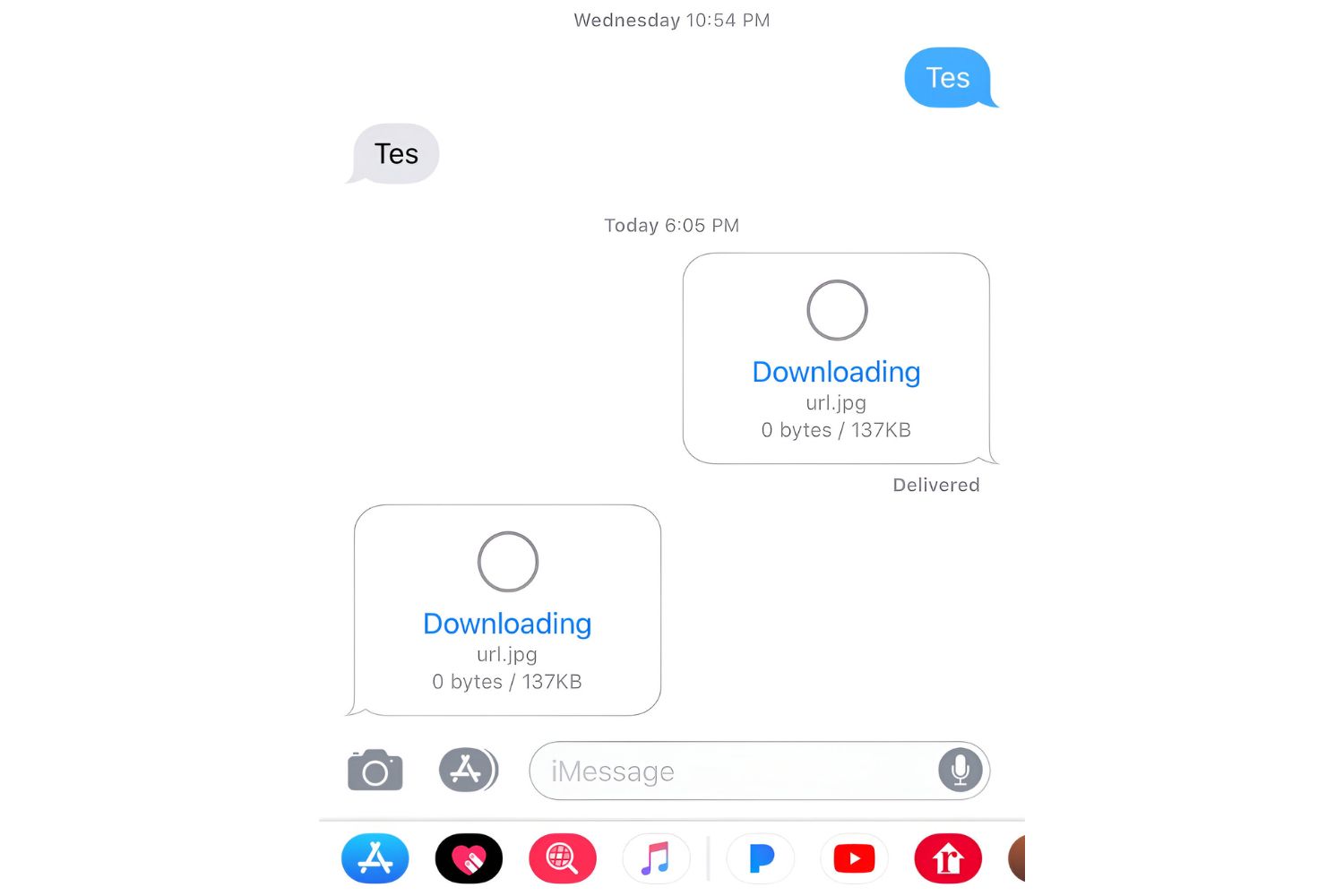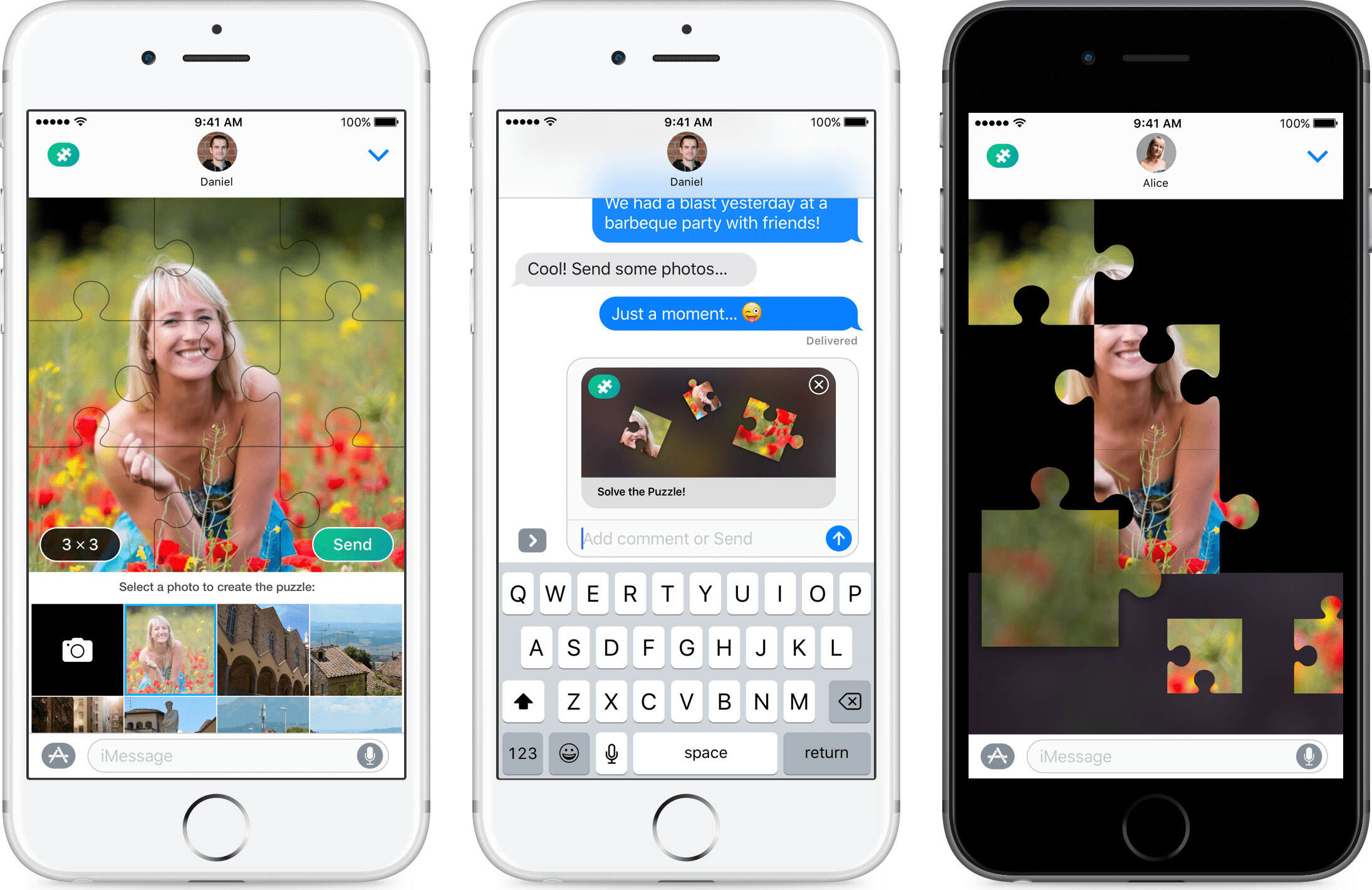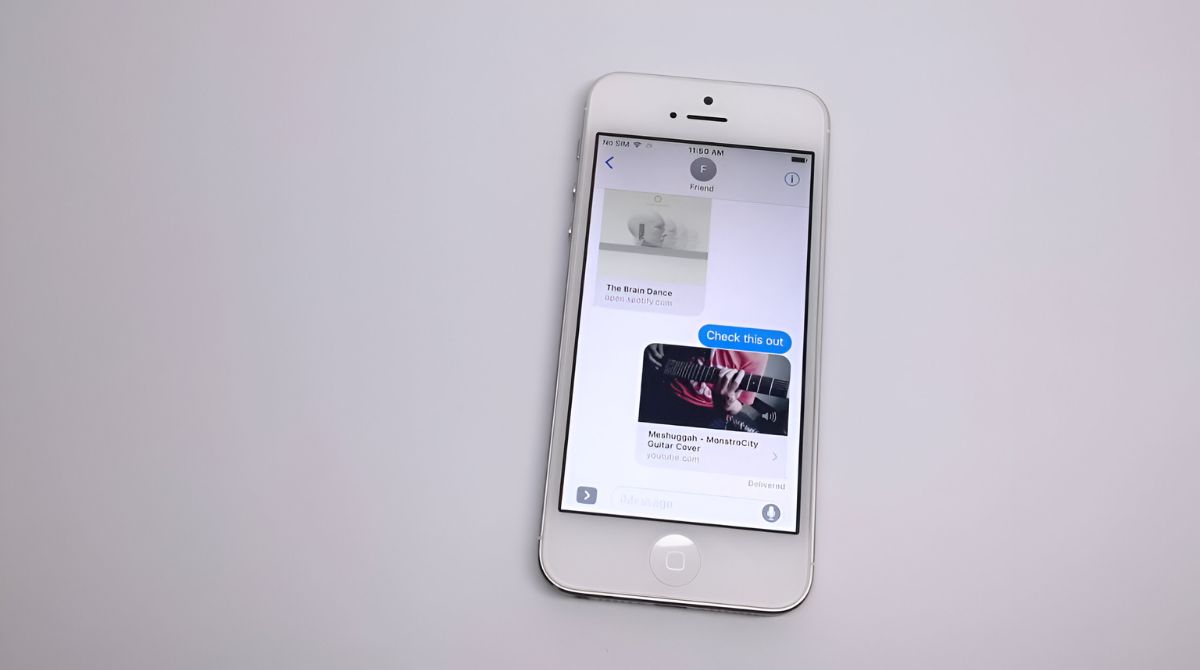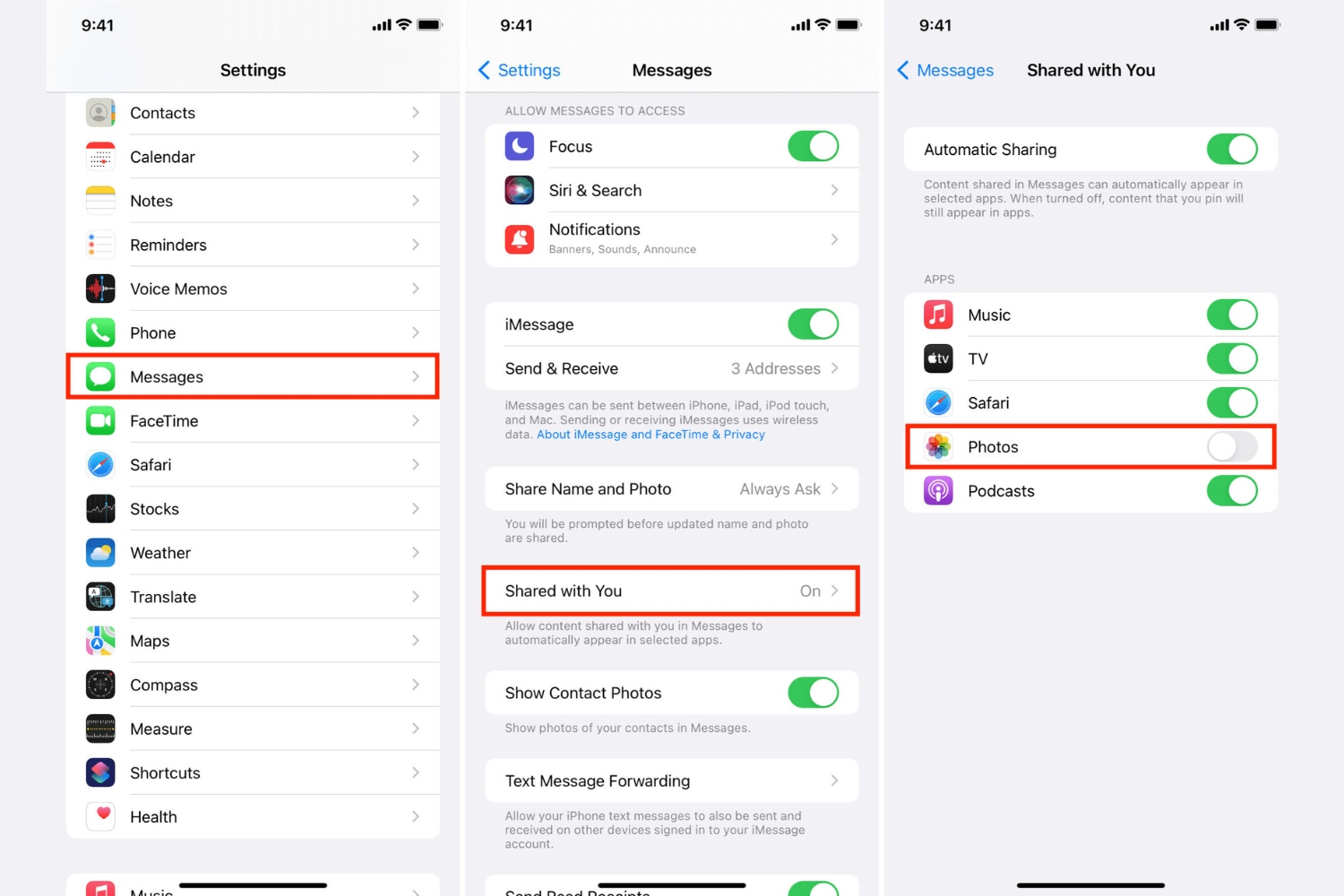Introduction
With the advancement of technology, communication has become increasingly visual. Users now rely on platforms like iMessage to exchange not only text but also images. However, it can be frustrating when these images fail to load properly. Whether it’s a memorable photo or an important document, not being able to view an image on iMessage can disrupt the flow of conversation and even affect productivity.
In this article, we will explore some of the common reasons behind images not loading on iMessage and provide practical solutions to resolve this issue. By understanding the underlying causes, you can take the necessary steps to ensure that your images load seamlessly on iMessage.
From connectivity issues to software updates and compatibility problems, there are various factors that can contribute to images not displaying correctly on iMessage. By identifying and addressing these issues, you can avoid frustrating situations and ensure a smooth communication experience.
So let’s dive into the details and discover the possible reasons why images won’t load on iMessage and how you can fix this issue to enjoy a seamless messaging experience.
Common Reasons Why Images Won’t Load on iMessage
When images fail to load on iMessage, there can be several underlying reasons. By understanding these common causes, you can troubleshoot the issue and get your images to load properly. Below are some of the most frequent reasons why images don’t appear on iMessage:
1. Issue with Cellular Data or Wi-Fi Connection: A weak or unstable internet connection is a common culprit behind images not loading on iMessage. If your cellular data or Wi-Fi signal is weak, it may struggle to download the image files, resulting in failed loading.
2. Disabled iMessage or MMS Settings: If iMessage or MMS (Multimedia Messaging Service) is disabled on your device, it won’t be able to receive or display images. Ensure that these settings are enabled to allow the proper functioning of image files.
3. Software Update Required: Outdated software can sometimes lead to compatibility issues, including problems with loading images on iMessage. Keeping your device’s operating system up to date ensures that you have the latest bug fixes and improvements, which can resolve this issue.
4. Low Device Storage: Insufficient storage space on your device can hinder the proper loading of image files. When your device storage is full, it can affect the functioning of apps, including iMessage. Clearing up space by deleting unnecessary files can help resolve this issue.
5. Large Image Files: If the image file you are trying to send or receive is too large, it may fail to load on iMessage. Large files take longer to download and, in some cases, may exceed the maximum file size allowed for messaging. Resizing or compressing the image can help overcome this problem.
6. Issue with Image Compatibility: Certain image formats may not be supported by iMessage, resulting in failure to load. Make sure the image file is in a compatible format, such as JPEG or PNG, to ensure smooth loading on iMessage.
7. Problem with the Sender’s Device or Network: Sometimes, the issue may not lie with your device or settings but instead with the sender’s device or network. Ask the sender to check their device and connection to ensure that the image was sent correctly.
By understanding and addressing these common reasons, you can troubleshoot and resolve the issue of images not loading on iMessage. In the next section, we will discuss specific solutions that can help fix this problem and ensure you can view and share images seamlessly on iMessage.
Issue with Cellular Data or Wi-Fi Connection
A weak or unstable cellular data or Wi-Fi connection can often be the culprit behind images not loading on iMessage. If your internet connection is not strong enough, it may struggle to download the image files, resulting in failed loading. Here are some steps you can take to resolve this issue:
1. Check your internet connection: Start by ensuring that your cellular data or Wi-Fi signal is strong and stable. If you’re using Wi-Fi, make sure you’re within range of the router and there are no obstructions. If you’re on cellular data, check the signal strength indicator on your device.
2. Switch between Wi-Fi and cellular data: If you’re experiencing issues with one type of connection, try switching to the other. Sometimes, switching from Wi-Fi to cellular data or vice versa can provide a more stable connection, allowing the images to load successfully.
3. Restart your router or modem: Restarting your router or modem can help refresh the internet connection and resolve any temporary glitches. Simply unplug the power source, wait for a few seconds, and then plug it back in. Give it a few moments to reconnect and then check if the images load on iMessage.
4. Reset network settings: If the issue persists, you can try resetting your network settings on your device. Go to the settings menu, find the “Reset” option, and select “Reset Network Settings.” Keep in mind that this will remove all saved Wi-Fi networks and Bluetooth connections, so make sure you have the necessary passwords and settings handy.
5. Contact your service provider: If you’ve tried all the above steps and still experience issues with your cellular data connection, reach out to your service provider for assistance. They may be able to troubleshoot the issue or provide guidance on improving your connection.
By addressing the issue with your cellular data or Wi-Fi connection, you can overcome the barrier of images not loading on iMessage. It’s important to have a reliable and stable internet connection to ensure smooth communication and seamless image sharing. In the next section, we will explore another common reason why images don’t load on iMessage – disabled iMessage or MMS settings.
Disabled iMessage or MMS Settings
If images are not loading on iMessage, one possible reason could be that iMessage or MMS (Multimedia Messaging Service) settings are disabled on your device. Disabling these settings prevents the proper functioning of image files. Here’s how you can check and enable these settings:
1. Enable iMessage: On your iPhone, go to the Settings app and scroll down to find “Messages”. Tap on it, and you will see the option to enable iMessage. Make sure the toggle switch next to iMessage is turned on (green).
2. Enable MMS: If iMessage is already enabled but you’re still experiencing issues with loading images on iMessage, it’s possible that MMS settings are disabled. To enable MMS, go to Settings > Messages > scroll down to “MMS Messaging” and make sure the toggle switch is turned on (green).
3. Check your Apple ID: Sometimes, issues with loading images on iMessage can occur if your device is not properly connected to your Apple ID. Make sure you are signed in to your Apple ID in the Settings app. Go to Settings > tap your name at the top of the screen > sign in with your Apple ID if necessary.
4. Verify phone number and email address: In the Messages settings, make sure that your phone number and email address are correct and selected for use with iMessage. This ensures that messages and images are properly linked to your account.
5. Toggle Airplane mode: If you’ve checked and enabled the necessary settings but images still won’t load on iMessage, try toggling Airplane mode on and off. This can help refresh your device’s network connections and may resolve the issue.
By ensuring that iMessage and MMS settings are properly enabled on your device, you can allow for the seamless transmission and loading of images on iMessage. In the next section, we will discuss another potential solution – updating your iOS software.
Software Update Required
If images are not loading on iMessage, it’s possible that your device’s software is outdated. Outdated software can lead to compatibility issues, including problems with loading images on iMessage. Here’s how you can update your iOS software to resolve this issue:
1. Check for software updates: Go to the Settings app on your device and navigate to “General.” From there, tap on “Software Update.” Your device will check for the latest available software update.
2. Download and install the update: If a software update is available, follow the prompts to download and install it. Make sure your device is connected to a stable Wi-Fi network and has sufficient battery power.
3. Enable automatic updates: To ensure you always have the latest software updates, you can enable the automatic update feature. Go to Settings > General > Software Update > Customize Automatic Updates, and toggle it on.
4. Connect to iTunes for updates: If you are unable to update your device’s software over the air, you can try connecting your device to a computer with iTunes installed. Launch iTunes, connect your device, and click on the device icon. From there, click on “Check for Update” and follow the instructions to update the software.
Regularly updating your iOS software not only ensures the smooth functioning of your device but also helps resolve any compatibility issues that may be causing images not to load on iMessage. Keeping your device up to date with the latest updates and bug fixes can improve overall performance and compatibility. In the next section, we will discuss another potential reason why images are not loading on iMessage – low device storage.
Low Device Storage
If images are not loading on iMessage, one possible reason could be that your device has low storage space. When your device’s storage is nearly full, it can hinder the proper loading of image files. Here are some steps you can take to free up device storage and resolve this issue:
1. Check your device’s storage: Go to the Settings app on your device and navigate to “General” and then “iPhone Storage” (or “iPad Storage” for iPad users). Here, you will see a breakdown of how your device’s storage is being utilized.
2. Delete unnecessary files and apps: Identify and delete any files, photos, videos, or apps that are no longer needed. You can selectively delete files or use the option to offload unused apps temporarily. Be sure to review the content before deleting to avoid unintentional removal of important files.
3. Transfer files to cloud storage: Consider using cloud storage services like iCloud, Google Drive, or Dropbox to store larger files and free up space on your device. Move files such as photos, videos, and documents to the cloud and access them whenever needed.
4. Clear app caches: Some apps on your device may accumulate cached data that can consume storage. Go to the Settings app, select the specific app, and look for options to clear cache or data. This can vary depending on the app, so explore the settings accordingly.
5. Offload unused apps: If you have apps that you rarely use but want to keep, you can offload them instead of deleting them completely. This removes the app from your device while keeping the associated data. To offload apps, go to Settings > General > iPhone Storage (or iPad Storage) and select the app you want to offload.
By freeing up storage space on your device, you can ensure that images load properly on iMessage. Removing unnecessary files and managing storage efficiently can benefit not only the loading of images but also the overall performance of your device. In the next section, we will discuss another aspect that can affect image loading on iMessage – large image files.
Large Image Files
If images are not loading on iMessage, it could be due to the size of the image files. Large image files take longer to download and can sometimes exceed the maximum file size allowed for messaging. Here are some steps you can take to address this issue:
1. Resize the image: If you have control over the image you’re sending or receiving, consider resizing it before sending it on iMessage. You can use photo editing tools or online resizing websites to adjust the image dimensions and reduce its file size.
2. Compress the image: Another option is to compress the image file without significantly compromising its quality. There are various image compression tools and software available that can reduce the file size while maintaining a satisfactory level of image quality.
3. Consider alternative file formats: Certain image file formats, such as TIFF or RAW, can be significantly larger than others, like JPEG or PNG. If possible, convert the image to a more compressed file format to reduce its size. However, keep in mind that some formats may not be supported by iMessage, so choose a compatible format.
4. Use file sharing platforms: If the image file size is too large to be sent directly on iMessage, consider using file sharing platforms like Dropbox or Google Drive. Upload the image to the platform and share the link with the recipient. This way, you bypass the restrictions of messaging file size limits.
5. Request smaller image files: If you are on the receiving end and images consistently fail to load, kindly ask the sender to resize or compress the image before sending it again. Communicating the issue can help both parties find a suitable resolution and ensure smooth image loading.
By resizing, compressing, or using alternative file formats, you can overcome the hurdle of large image files not loading on iMessage. Properly optimizing the image size can enhance the speed of file transfer and increase the chances of successful image loading. In the next section, we will explore another potential reason why images may not load on iMessage – compatibility issues.
Issue with Image Compatibility
When images fail to load on iMessage, it’s possible that there is an issue with the compatibility of the image file. Certain image formats may not be supported by iMessage, resulting in failed loading. Here’s how you can address this compatibility issue:
1. Check the image format: Ensure that the image file you are trying to send or receive is in a supported format. Commonly supported formats for iMessage include JPEG and PNG. If the image is in a different format, consider converting it to a compatible format before sending it.
2. Use a third-party app: If you frequently encounter compatibility issues with certain image formats on iMessage, you can try using a third-party app specifically designed for image conversion. These apps can help convert images to compatible formats without reducing the quality significantly.
3. Verify file extension: In some cases, the file extension of an image may not match its actual format. Renaming the file to have the correct extension can sometimes resolve compatibility issues. For example, if the file is a JPEG image but has an incorrect extension like .png, rename it to have the .jpeg or .jpg extension.
4. Ask the sender for a compatible format: If you’re having trouble viewing images sent by someone else, kindly ask the sender to send the image in a compatible format. Communicating the issue can help both parties find a suitable solution and ensure successful image loading.
5. Preview the image on a computer: If you have access to a computer, try previewing the image on it. Sometimes, formatting issues are specific to the device or software you are using. Previewing the image on a computer can help determine if the issue lies with the image file itself or its compatibility with iMessage.
By checking image formats, using third-party apps for conversion, and ensuring proper file extensions, you can overcome compatibility issues and ensure that images load successfully on iMessage. Understanding and addressing compatibility issues is crucial for seamless communication and image sharing. In the next section, we will discuss another potential reason why images may not load on iMessage – problems with the sender’s device or network.
Problem with the Sender’s Device or Network
When images are not loading on iMessage, it’s important to consider that the issue may not lie with your device or settings, but instead with the sender’s device or network. Problems on their end can prevent images from being successfully sent or received. Here are some factors to consider:
1. Sender’s device: The sender’s device may have technical issues that prevent it from properly sending images. It could be a software glitch, a memory problem, or an issue with the messaging app itself. Encourage the sender to check their device for any updates, restart it, or try sending the image from a different device if possible.
2. Sender’s network: Network connectivity on the sender’s end may be weak or unstable, causing issues with image transmission. Factors such as network congestion, low signal strength, or temporary outages can disrupt the sending of images. Ask the sender to check their network connection and try resending the image when the connection is stronger.
3. File size limit: If the image being sent exceeds the file size limit imposed by the sender’s network or messaging app, it may fail to be delivered. In such cases, the sender may need to compress the image or use an alternative method such as cloud storage or file sharing platforms.
4. Compatibility issues on the sender’s end: The sender’s device or messaging app may have compatibility issues with the image file format or iMessage itself. They can try converting the image to a compatible format or using a different messaging app to send the image.
5. Network restrictions: In some cases, the sender’s network may have restrictions or firewalls in place that prevent certain types of files or media from being sent. It’s worth confirming with the sender if they are experiencing any restrictions on their network that could affect image transmission.
Communicating with the sender and troubleshooting together can help identify and resolve any issues on their end that may be causing images not to load on iMessage. By ensuring both parties have functioning devices and stable network connections, you can improve the success rate of image sending and receiving. As we move forward, we will explore various ways to fix images not loading on iMessage.
Ways to Fix Images Not Loading on iMessage
When images fail to load on iMessage, there are several steps you can take to troubleshoot and resolve the issue. By following these methods, you can ensure that images load seamlessly on iMessage. Here are some effective ways to fix images not loading on iMessage:
1. Check your internet connection: Ensure that your cellular data or Wi-Fi connection is strong and stable. Weak or unstable connections can hinder the downloading of image files.
2. Enable iMessage or MMS settings: Make sure that both iMessage and MMS settings are enabled on your device. These settings allow for the transmission and display of images on iMessage.
3. Update your iOS software: Keep your device’s software up to date by installing the latest iOS updates. This ensures compatibility and resolves any bugs or issues that may affect image loading on iMessage.
4. Free up device storage: Check your device’s storage and delete any unnecessary files or apps to free up space. Insufficient storage can hinder the proper loading of image files on iMessage.
5. Resize or compress image files: If the image files are too large, consider resizing or compressing them before sending or receiving on iMessage. This reduces the file size and increases the chances of successful loading.
6. Verify image compatibility: Ensure that the image file format is supported by iMessage. Convert the image to a compatible format if needed or communicate with the sender to confirm compatibility.
7. Troubleshoot the sender’s device or network: If you are consistently experiencing issues with images from a specific sender, it may be worthwhile to troubleshoot their device or network. Encourage them to check their settings, update their software, or resend the image from a different device or network.
By following these steps, you can address common issues and ensure that images load successfully on iMessage. Remember to communicate with the sender and troubleshoot together to identify and resolve any issues on their end as well. A reliable internet connection, proper settings, and optimized image files are essential for a seamless image sharing experience on iMessage.
Check Internet Connection
When images fail to load on iMessage, the first and most crucial step is to check your internet connection. A weak or unstable internet connection can prevent the proper downloading of image files, leading to images not loading on iMessage. Here are some steps to check and improve your internet connection:
1. Ensure Wi-Fi or cellular data is enabled: Make sure that your Wi-Fi or cellular data is turned on and functioning properly. You can do this by going to the Settings app on your device and checking the status of your Wi-Fi or cellular data connection.
2. Check the signal strength: If you’re using Wi-Fi, check the signal strength indicator on your device. Ensure that you’re within range of the router and that there are no obstructions interfering with the signal. If you’re using cellular data, check the signal bars on your device to ensure a strong and stable connection.
3. Restart your Wi-Fi router or modem: Sometimes, a simple restart of your Wi-Fi router or modem can resolve connectivity issues. Unplug the power source, wait for a few seconds, and then plug it back in. Give it a few moments to reconnect, and then try loading the images on iMessage again.
4. Disconnect and reconnect to Wi-Fi: If you’re connected to a Wi-Fi network, try disconnecting and reconnecting to it. This can force your device to establish a fresh connection, which may improve the stability of your internet connection and solve any temporary issues.
5. Switch between Wi-Fi and cellular data: If you’re experiencing issues with your current internet connection, try switching to the alternative connection type. For example, if you’re using Wi-Fi, switch to cellular data, or vice versa. Sometimes, one connection type may offer a more stable and reliable internet connection.
6. Troubleshoot network connectivity issues: If the above steps don’t resolve the issue, you can try troubleshooting network connectivity problems. This can include resetting network settings, forgetting and rejoining Wi-Fi networks, or contacting your internet service provider for further assistance.
By checking and improving your internet connection, you can ensure a stable and reliable connection for downloading and loading images on iMessage. Remember, a strong internet connection is essential for seamless communication and the successful sharing of images.
Enable iMessage or MMS Settings
If images are not loading on iMessage, it’s important to ensure that both iMessage and MMS (Multimedia Messaging Service) settings are enabled on your device. Disabling these settings can prevent the proper transmission and display of images. Here’s how you can check and enable these settings:
1. Enable iMessage: On your iPhone, go to the Settings app and scroll down to find “Messages”. Tap on it, and you will see the option to enable iMessage. Make sure the toggle switch next to iMessage is turned on (green). If it is already enabled, try disabling it and then re-enabling it to refresh the settings.
2. Enable MMS: In addition to iMessage, make sure that MMS settings are also enabled on your device. MMS allows for the sending and receiving of multimedia, including images, via text messages. To enable MMS, go to Settings > Messages > scroll down to “MMS Messaging” and make sure the toggle switch is turned on (green).
3. Verify phone number and email address: In the Messages settings, ensure that your phone number and email address are correct and selected for use with iMessage. This ensures that messages and images are properly linked to your account. If they are incorrect or missing, update the information accordingly.
4. Check Apple ID sign-in: Confirm that you are signed in with your Apple ID in the Settings app. Go to Settings > tap your name at the top of the screen > sign in with your Apple ID if necessary. Signing in with your Apple ID allows for the proper functioning of iMessage and image transmission.
5. Toggle iMessage off and on: If you’re still experiencing issues with images not loading on iMessage, try toggling iMessage off and then back on. This can help refresh the connection and settings, potentially resolving any glitches or conflicts that may be causing the issue.
By ensuring that both iMessage and MMS settings are properly enabled on your device, you allow for the smooth transmission and display of images on iMessage. Double-checking these settings and performing the necessary adjustments can help resolve any issues related to them. In the next section, we will discuss another potential solution – updating your iOS software.
Update iOS Software
Keeping your iOS software up to date is crucial for ensuring the smooth functioning of your device, including the proper loading of images on iMessage. Outdated software can lead to compatibility issues, which can prevent images from loading successfully. Here’s how you can update your iOS software to resolve this issue:
1. Check for software updates: Start by checking if there are any available software updates for your device. Go to the Settings app on your iPhone or iPad and navigate to “General.” From there, tap on “Software Update.” Your device will check for the latest available software update.
2. Download and install the update: If a software update is available, follow the prompts to download and install it. Make sure your device is connected to a stable Wi-Fi network and has sufficient battery power. The installation process may take some time, so be patient during the update.
3. Enable automatic updates: To ensure you always have the latest software updates, you can enable the automatic update feature. Go to Settings > General > Software Update > Customize Automatic Updates, and toggle it on. With this feature enabled, your device will automatically download and install updates while connected to Wi-Fi and charging.
4. Connect to iTunes for updates: If you are unable to update your device’s software over the air, you can try connecting your device to a computer with iTunes installed. Launch iTunes, connect your device, and click on the device icon. From there, click on “Check for Update” and follow the instructions to update the software.
Regularly updating your iOS software ensures compatibility and resolves any bugs or issues that may affect image loading on iMessage. It’s recommended to keep your device up to date with the latest updates and improvements provided by Apple. By updating your software, you can potentially overcome any software-related obstacles and ensure a smoother image sharing experience on iMessage. In the next section, we will discuss another factor that can affect image loading – low device storage.
Free Up Device Storage
If images are not loading on iMessage, one possible reason could be that your device’s storage is running low. Insufficient storage space can hinder the proper loading of image files and affect the overall performance of your device. Here are some steps you can take to free up device storage and address this issue:
1. Review and delete unnecessary files: Go through your device and identify any files, documents, photos, or videos that are no longer needed. Delete these unnecessary files to free up space on your device. You can do this by tapping and holding the file, then selecting the delete option.
2. Clear app caches: Some apps accumulate cached data over time, taking up valuable storage space. Go to the Settings app, select the specific app, and look for options to clear the app’s cache or data. This will help reclaim storage space and can potentially improve the loading of images on iMessage.
3. Delete unwanted apps: Take a look at the apps installed on your device and identify any that you no longer use or need. Deleting unused apps not only frees up storage space but also declutters your device’s interface. Press and hold the app icon on the home screen, then tap the delete option (the “x” icon).
4. Offload unused apps: If you want to retain certain apps but free up space, you can offload them. Offloading removes the app from your device while preserving the associated data. To offload apps, go to Settings > General > iPhone (or iPad) Storage > tap on the app you want to offload > select “Offload App.”
5. Transfer files to external storage or cloud services: Consider transferring larger files, such as photos, videos, and documents, to external storage devices or cloud services. Use services like iCloud, Google Drive, or Dropbox to store files and access them when needed, freeing up space on your device.
6. Manage your photo library: Photos can consume a significant amount of storage space. Review your photo library and delete unnecessary or duplicate photos. You can also enable the “Optimize iPhone Storage” option in the Photos settings, which replaces full-resolution photos with smaller versions to save storage.
By freeing up storage space on your device, you can resolve issues related to low storage that may be affecting the loading of images on iMessage. A well-managed storage space ensures smoother performance, including the seamless loading of images and other media. In the next section, we will discuss how the file size of images can impact their loading on iMessage and provide solutions to overcome this issue.
Compress Image Files
Large image files can present a challenge when it comes to loading them on iMessage. If the image files you’re sending or receiving are too large, they may take longer to download or exceed the maximum file size limit, resulting in failed loading. To address this issue, you can compress image files to reduce their size without significantly compromising the quality. Here are some steps you can take to compress image files:
1. Use image compression apps: There are several dedicated image compression apps available that can help you reduce the file size of your images. These apps typically offer various compression settings, allowing you to choose an optimum balance between file size and image quality.
2. Online image compression tools: Online image compression websites provide a simple and convenient way to compress image files. These tools usually allow you to upload your image, select the desired compression level, and then download the compressed version.
3. Adjust image dimensions: Resizing an image to smaller dimensions can significantly reduce the file size. Consider reducing the image resolution or dimensions while maintaining the aspect ratio to create a smaller version of the image.
4. Save images with optimized settings: When saving images, ensure that you select the appropriate file format and compression settings. Different file formats, such as JPEG or PNG, have varying levels of compression and can affect the resulting file size.
5. Consider using the High Efficiency Image Format (HEIC): If your device supports it, using the HEIC format can provide high-quality images with smaller file sizes compared to traditional formats like JPEG.
6. Experiment with different compression levels: Some image editing software or apps allow you to adjust the compression level manually. Test different compression levels to find the balance between file size reduction and image quality that suits your needs.
By compressing image files, you can reduce their size and improve the chances of successful loading on iMessage. Be mindful that excessive compression can result in noticeable loss of image quality, so it’s important to find the right balance. Compressed images not only load faster but also require less storage space on both the sender’s and recipient’s devices. In the next section, we will discuss how image compatibility can impact loading on iMessage and provide ways to overcome compatibility issues.
Identify Compatibility Issues
Compatibility issues with image files can hinder their loading on iMessage. Not all image formats are supported by iMessage, and attempting to send or receive unsupported formats can result in failed loading. To ensure smooth image transmission and loading, it’s essential to identify and address compatibility issues. Here’s how you can overcome compatibility issues:
1. Check the image format: Verify that the image file you’re sending or receiving is in a format supported by iMessage. Commonly supported formats include JPEG and PNG. If the image is in a different format, consider converting it to a compatible format before sending it.
2. Convert the image format: If you have an image in an unsupported format, you can use image editing software or online converters to convert it to a compatible format. These tools allow you to maintain the quality of the image while ensuring it is in a format that iMessage can recognize.
3. Confirm the file extension: Sometimes, an image file may have an incorrect file extension that doesn’t match its actual format. In such cases, renaming the file with the correct file extension can help resolve compatibility issues. For example, if the file is a JPEG image with a .png extension, rename it to have the .jpeg or .jpg extension.
4. Use a third-party app for conversion: If you frequently encounter compatibility issues with certain image formats on iMessage, you can try using a third-party app specifically designed for image conversion. These apps can help convert images to compatible formats without significantly compromising their quality.
5. Communicate with the sender: If you’re experiencing difficulty loading images sent by someone else, kindly ask the sender to send the image in a compatible format. Clear communication can help both parties find a suitable solution and ensure successful image loading.
By ensuring that image files are in compatible formats, you can prevent compatibility issues and improve the loading of images on iMessage. It’s important to be aware of the supported file formats and perform any necessary conversions to ensure seamless image transmission. In the next section, we will discuss troubleshooting methods for identifying if the issue lies with the sender’s device or network.
Troubleshoot Sender’s Device or Network
When images are not loading on iMessage, it’s essential to consider that the issue may lie with the sender’s device or network. Problems on their end can prevent images from being successfully sent or received. Here are some troubleshooting methods to identify if the issue is with the sender’s device or network:
1. Confirm communication with the sender: Reach out to the sender and inquire if they are experiencing any difficulties with their device or network. Communication can help identify any potential issues on their end and provide insights into resolving the problem.
2. Suggest device restart: Ask the sender to restart their device. Restarting can often resolve minor software glitches that may be affecting the proper functioning of their device.
3. Check for software updates: Encourage the sender to check for any available software updates on their device. Outdated software can sometimes cause compatibility issues and hinder the loading of images on iMessage. Updating to the latest software version can potentially resolve the problem.
4. Suggest trying from a different device: If the sender is experiencing consistent issues with their device, recommend that they try sending the image from a different device. This can help determine if the problem is specific to their device or network.
5. Ask about network connectivity: Inquire about the sender’s network connectivity. Weak or unstable network connections can interrupt the transmission of images and result in failed loading. Ensure that they have a stable internet connection and suggest reconnecting or switching networks if needed.
6. Verify file size limit restrictions: Some networks or messaging apps impose file size limits on image transfers. Inquire if the sender is aware of any restrictions and if the image being sent falls within the allowed file size. If necessary, suggest compressing the image or using alternative methods, such as cloud storage or file-sharing platforms.
By troubleshooting the sender’s device and network, you can determine if the issue lies on their end. Communicating with the sender and carrying out these troubleshooting methods can provide valuable insights and help identify potential resolutions. Collaborating with the sender ensures a more effective and efficient resolution to the problem.
Conclusion
When images fail to load on iMessage, it can be frustrating and hinder smooth communication. However, by understanding and addressing the common reasons for this issue, you can troubleshoot and resolve the problem effectively. We have explored various potential causes, including issues with cellular data or Wi-Fi connection, disabled iMessage or MMS settings, outdated software, low device storage, large image files, compatibility issues, and problems with the sender’s device or network.
To fix images not loading on iMessage, we have provided practical solutions such as checking the internet connection, enabling iMessage or MMS settings, updating iOS software, freeing up device storage, compressing image files, identifying compatibility issues, and troubleshooting the sender’s device or network. By following these steps, you can improve the chances of images loading seamlessly on iMessage and ensure a smooth and enjoyable messaging experience.
Remember to keep your device’s software up to date, maintain sufficient storage space, and pay attention to image file formats and sizes. Communication with the sender and troubleshooting together can also help identify and address issues that may be specific to their device or network.
By taking these proactive measures, you can overcome obstacles and ensure the successful transmission and loading of images on iMessage. Embrace the visual nature of modern communication and enjoy the seamless sharing of memorable moments and important information via iMessage.







